Why is Poland raising a claim for reparations?
Poland is claiming reparations for:
- the damage and loss caused by the Germans during the Second World War, and
- the continuing negative effects of that damage in numerous areas that continue until today.
The amount of reparations that Poland is claiming is PLN 6,220,609 million as of 31 December 2021.
Until today, Poland and Germany have not signed a treaty to end the Second World War. Therefore, the issue of reparations and compensation remains open and must be resolved.
Backround
There can be no doubt that Germany started the Second World War and committed both war crimes and crimes against humanity, and caused massive material losses in Poland.
In starting the Second World War, Germany breached the terms of the 1907 Hague Convention which states in Article 3:
"A belligerent party which violates the provisions of the said Regulations shall, if the case demands, be liable to pay compensation. It shall be responsible for all acts committed by persons forming part of its armed forces."
Therefore, the next question is what form of compensation is adequate? Generally speaking, after war, discussions refer to "reparations". Wikipedia defines war reparations as "compensation payments made after a war by one side to the other. They are intended to cover damage or injury inflicted during a war.”
The development of recent human rights legislation also refers to compensation for individual losses. As such, compensation and reparations are terms that are both used to refer to human and material loss.
International law does not recognise the statute of limitations for war crimes or crimes against humanity. The 1968 Convention on the Non-Applicability of Statutory Limitations to War Crimes (pdf) states that no statutory limitation applies to war crimes or crimes against humanity, irrespective of the date of their commission. This means the war crimes committed in the Second World War are also covered by this provision. Therefore, a victim of these crimes can claim compensation at any time.
Further, Poland and Germany have never signed a peace treaty to settle the issue of the Second World War. Poland did not sign either the Potsdam Agreement or the Two Plus Four Treaty. Treaties are signed to formally close issues. As Poland and Germany did not sign a treaty to end the Second World War, the issue of reparations remains open.
Below, we briefly investigate the areas in which Poland suffered damage and loss and how this still affects Poland today. We also encourage you to read the abridged version of the War Report and the full War Report which also presents this information.
The areas where Poland suffered losses:
- Losses due to the changes in Poland's borders
- Poland's demographic losses
- Health impairment and diseases
- The economic value of human losses
- Material losses and loss of cultural assets
- Losses in banking and insurance, and State Treasury Losses
- Estimation of GDP losses
Other questions are related to why Poland is raising a claim for reparations now, e.g. why the War Report was only published in 2022 and why the topic of reparations is still open. We also encourage you to click on those links and the links at the bottom of this page and read more on the pages dedicated to those questions.
Losses due to the changes in Poland's borders
Before the war, the area of Poland was almost 389,000 km2. However, after the war and the changes to Poland’s borders, the area of Poland was 312,500 km2.
Therefore, the area of Poland decreased by 78,000 km2. This loss has not been compensated.
To put that figure into perspective, please see the graphic below which demonstrates the size of land loss.
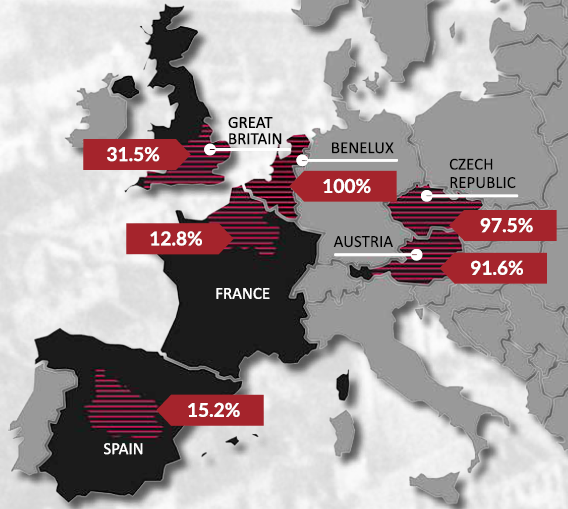
78,000 km2 is equivalent to:
- 31.5% of the land mass of Great Britain,
- 12.8% of the land mass of France,
- 15.2% of the land mass of Spain,
- 100% of the land mass of the Benelux area,
- 97.5% of the land mass of Czechia, or
- 91.6% of the land mass of Austria
A popular misconception is that Poland received Germany’s “most advanced” lands as a form of post-war reparations. However, this is incorrect. Poland’s borders were changed during the Yalta and Potsdam Conferences and finalised in the Two Plus Four Agreement. German lands were not a form of reparations but a result of the map of Europe being redrawn. We discuss this issue in more detail here, Didn’t Poland get reparations by getting German land?
Poland's demographic losses
5,219,000 Polish citizens died during the Second World War. 21% of that figure were children under the age of 10.
However, in terms of Poland’s population, between 1939 and 1946, Poland’s population decreased by 11.2 million.

With the exception of a small group of Poles that received a token financial gesture in the early 90s, this loss in human potential has not been compensated.
As well as human loss as a direct result of German occupation (please refer to Volume III of the War Report for more information), Poland suffered population loss due to these reasons:
German concentration and extermination camps
It is impossible to know the exact figure of Jews murdered in the Holocaust, Poles, and other minority groups in German death camps in Poland. Estimates calculate that number of people murdered was above 3.2 million people.
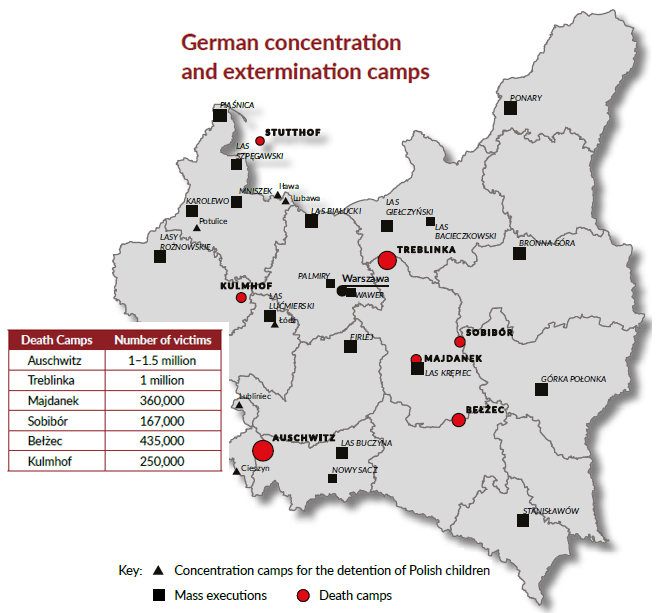
Slave labour and stolen children
Over 2.1 million Polish citizens were taken abroad as slave labour, and over 200,000 German enterprises and farms, among others, Siemens, Allianz, Audi, BMW, Deutsche Bank, Mercedes-Benz, Opel, Porsche and Volkswagen AG, benefited from the work of Polish forced labourers. It is impossible to estimate the number of slave labourers who died, stayed in Germany, or returned to Poland.
The Germans selected 196,000 Polish children to be sent to Germany for Germanisation. Only 30,000 children returned.
Losses in Polish intelligentsia
The Germans very quickly aimed to eliminate the Polish intelligentsia, i.e. doctors, lawyers, teachers, clergy, and other officials, as these groups were seen as potential Polish leaders that could lead Poles against the Germans.
At least 100,000 people died in the German operations to liquidate the Polish intelligentsia.
Reduced birth rate during the war
The German policy of limiting food rations for Poland's population had a dramatic, negative effect on the birth rate. 22% fewer births occurred in 1943 in comparison to 1938. German policy also targeted children who were born by limiting available food products to weaken young children and increase their mortality.
For the Jewish population who were being held in ghettos, the situation was considerably worse.
The Germans did everything they could to prevent the black market trade of food items and brutally punished those who were caught in the black market supply of farm produce.
Migration
It is impossible to accurately estimate the amount of Polish citizens who managed to escape Poland and resettle in other countries, e.g. the UK, the USA, France or further afield.
However, it is clear that a large number did manage to escape and did not return to Poland. Those who did return to communist Poland were very often persecuted.
These losses have never been compensated.
Health impairment and diseases
5 years of German occupation and poor nutrition led the Polish population who survived the War to suffer from long-term health problems and diseases.
The table below, using figures from the war report conducted just after the War, indicates the scale of how many people were affected.
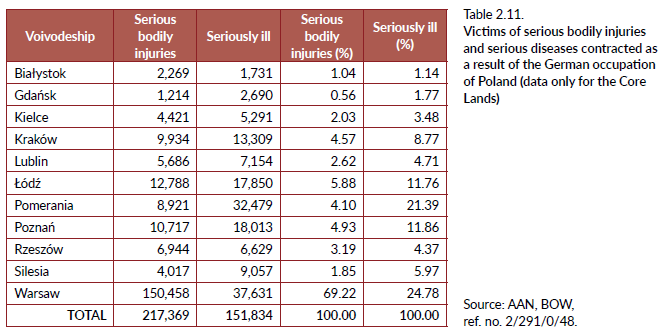
217,369 suffered serious bodily injuries and 151,834 were seriously ill. Over a million people developed tuberculosis mainly due to long-term malnutrition during the occupation.
The number of invalids in Poland’s post-war population amounted to about 590 thousand. These individuals could not take up a job, and many of them needed to be in permanent care.
However, we will never know the exact number of people who suffered because of the war.
The economic value of human losses
Loss of human life on such a scale affects the potential future that a country may have had.
Modelling suggests that, after the end of the Second World War, the Polish nation needed 33 years, i.e. until 1978 to rebuild its human potential to the level from before the war.
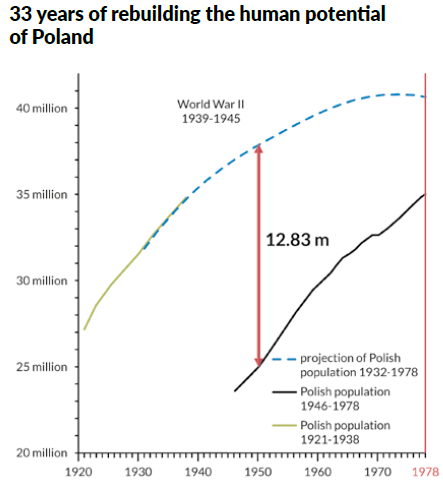
In terms of the lost remuneration and the loss of GDP due to human losses during the war, Poland lost PLN 4.3 trillion. This is a purely economic figure that does not take into account suffering, broken families and psychological trauma.
In terms of lost GDP for those who survived the War, this is calculated at PLN 497.9 billion.
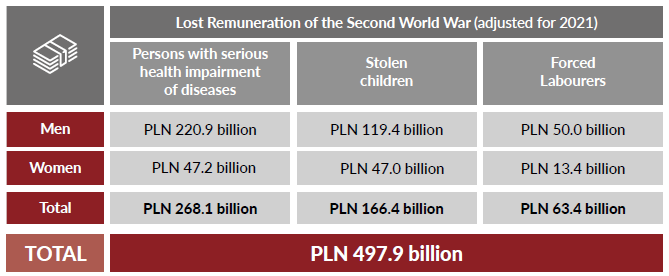
These losses have never been compensated.
Material losses and loss of cultural assets
Based on the records that were available after the War, the amount of losses for the loss of material losses is estimated at almost PLN 797.4 billion.
The methods used to estimate losses were based on the type of archival information available. Based on those records, tangible assets were estimated at their prices when destroyed, confiscated, or stolen, as were assessed lost profits based on the infrastructure at the time. Only when assessing agricultural assets were prices converted to today's values.
Because of the war and German occupation, Poland suffered losses in cultural assets and works of approx. PLN 19.3 million.
An important note about Poland's cultural and art losses. Due to the lack of precise data on exactly what was lost or stolen from Poland, the full value of the losses can never be determined. All estimates and calculations are therefore indicative and are based on the most conservative approach of how to limit those losses.
These losses have never been compensated.
Losses in banking and insurance, and State Treasury Losses
Because of acts of war and German occupation, Poland suffered the following losses:
- Polish credit and savings institutions and their customers, over PLN 89.3 billion,
- Polish social security institutions and insurance companies, PLN 34.8 billion, and
- The State Treasury, PLN 492.8 billion.
These losses have never been compensated.
Estimation of GDP losses
The effect of the War halved the Poles’ ability to generate wealth. The potential lost during the Second World War that then had to be regained prevented Poland from being in the economic position it would otherwise have been in.
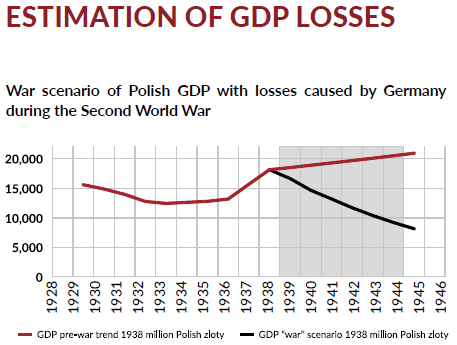
The lost GDP potential has never been compensated.
--
Click here to go back to the main page about Reparations for Poland.
Find out more about:
- How much reparations does Poland want for the Second World War?
- What demands did the Polish government make to Germany?
- Who wrote the War Report and why?
- Why is the issue of reparations for Poland being raised now?
- Wasn’t the issue of reparations for Poland closed?
- Didn’t Poland get reparations by getting German land?
- Milestones and Activities in Poland’s Campaign for Second World War Reparations
- Is reparations for Poland in the media?
